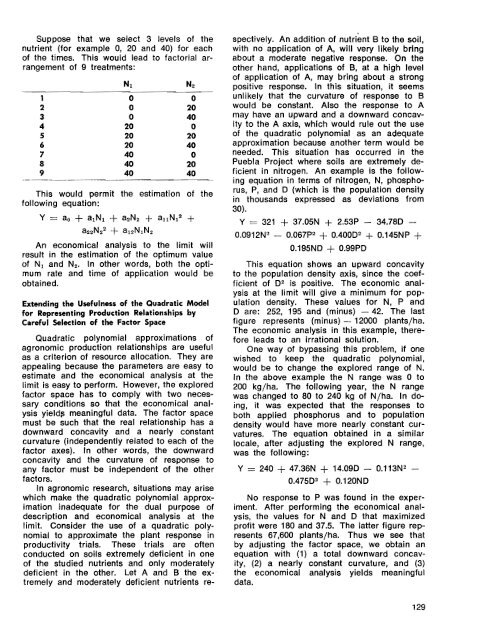REPORT - Search CIMMYT repository
REPORT - Search CIMMYT repository
REPORT - Search CIMMYT repository
You also want an ePaper? Increase the reach of your titles
YUMPU automatically turns print PDFs into web optimized ePapers that Google loves.
Suppose that we select 3 levels of the<br />
nutrient (for example 0, 20 and 40) for each<br />
of the times. This would lead to factorial arrangement<br />
of 9 treatments:<br />
1<br />
2<br />
3<br />
4<br />
5<br />
6<br />
7<br />
8<br />
9<br />
o<br />
o<br />
20<br />
20<br />
20<br />
40<br />
40<br />
40<br />
o<br />
20<br />
40<br />
o<br />
20<br />
40<br />
o<br />
20<br />
40<br />
This would permit the estimation of the<br />
following equation:<br />
Y = ao + a1N1 + a2N2 + allN12 +<br />
a22N22 + a12N1N2<br />
An economical analysis to the limit will<br />
result in the estimation of the optimum value<br />
of N1 and N2. In other words, both the optimum<br />
rate and time of application would be<br />
obtained.<br />
Extending the Usefulness of the Quadratic Model<br />
for Representing Production Relationships by<br />
Careful Selection of the Factor Space<br />
Quadratic polynomial approximations of<br />
agronomic production relationships are useful<br />
as a criterion of resource allocation. They are<br />
appealing because the parameters are easy to<br />
estimate and the economical analysis at the<br />
limit is easy to perform. However, the explored<br />
factor space has to comply with two necessary<br />
conditions so that the economical analysis<br />
yield~ meaningful data. The factor space<br />
must be such that the real relationship has a<br />
downward concavity and a nearly constant<br />
curvature (independently related to each of the<br />
factor axes). In other words, the downward<br />
concavity and the curvature of response to<br />
any factor must be independent of the other<br />
factors.<br />
In agronomic research, situations may arise<br />
which make the quadratic polynomial approximation<br />
inadequate for the dual purpose of<br />
description and economical analysis at the<br />
limit. Consider the use of a quadratic polynomial<br />
to approximate the plant response in<br />
productivity trials. These trials are often<br />
conducted on soils extremely deficient in one<br />
of the studied nutrients and only moderately<br />
deficient in the other. Let A and B the extremely<br />
and moderately deficient nutrients re-<br />
spectively. An addition of nutrient B to the soil,<br />
with no application of A, will very likely bring<br />
about a moderate negative response. On the<br />
other hand, applications of B, at a high level<br />
of application of A, may bring about a strong<br />
positive response. In this situation, it seems<br />
unlikely that the curvature of response to B<br />
would be constant. Also the response to A<br />
may have an upward and a downward concavity<br />
to the A axis, which would rule out the use<br />
of the quadratic polynomial as an adequate<br />
approximation because another term would be<br />
needed. This situation has occurred in the<br />
Puebla Project where soils are extremely deficient<br />
in nitrogen. An example is the following<br />
equation in terms of nitrogen, N, phosphorus,<br />
P, and 0 (which is the population density<br />
in thousands expressed as deviations from<br />
30).<br />
Y = 321 + 37.05N + 2.53P - 34.780 <br />
0.0912N2 - 0.067p2 + 0.4000 2 + 0.145NP +<br />
0.195NO + 0.99PO<br />
This equation shows an upward concavity<br />
to the population density axis, since the coefficient<br />
of 0 2 is positive. The economic analysis<br />
at the limit will give a minimum for population<br />
density. These values for N, P and<br />
o are: 252, 195 and (minus) - 42. The last<br />
figure represents (minus) - 12000 plants/ha.<br />
The economic analysis in this example, therefore<br />
leads to an irrational solution.<br />
One way of bypassing this problem, if one<br />
wished to keep the quadratic polynomial,<br />
would be to change the explored range of N.<br />
In the above example the N range was 0 to<br />
200 kg/ha. The following year, the N range<br />
was changed to 80 to 240 kg of N/ha. In doing,<br />
it was expected that the responses to<br />
both applied phosphorus and to population<br />
density would have more nearly constant curvatures.<br />
The equation obtained in a similar<br />
locale, after adjusting the explored N range,<br />
was the following:<br />
Y = 240 + 47.36N + 14.090 - 0.113N2 <br />
0.4750 2 + O.120NO<br />
No response to P was found in the experiment.<br />
After performing the economical analysis,<br />
the values for Nand 0 that maximized<br />
profit were 180 and 37.5. The latter figure represents<br />
67,600 plants/ha. Thus we see that<br />
by adjusting the factor space, we obtain an<br />
equation with (1) a total downward concavity,<br />
(2) a nearly constant curvature, and (3)<br />
the economical analysis yields meaningful<br />
data.<br />
129

















